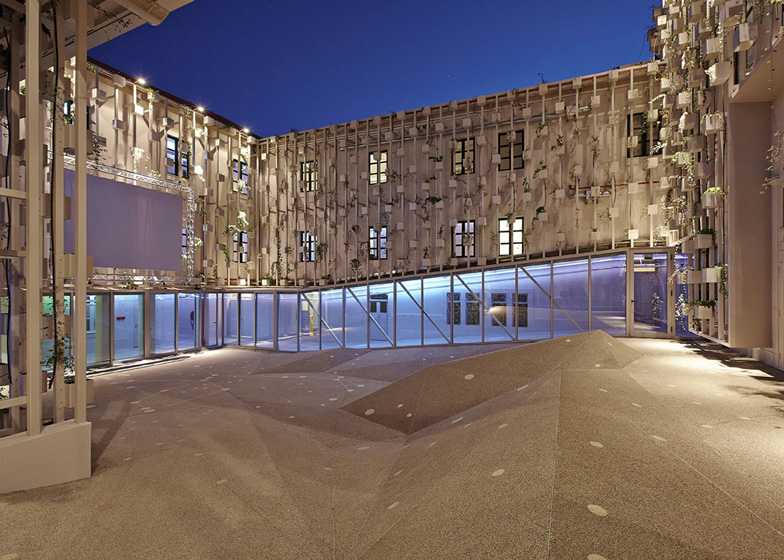Portuguese atelier Carvalho Araújo has converted an old military police headquarters in Braga, Portugal, into an art and culture centre with plant pots covering its walls (+ slideshow).
Named GNRation, a mash-up of Generation Lab and the GNR police, the centre offers a series of exhibition spaces, meeting places and work studios for young artists, designers and creatives.
Rather than stripping the building bare and renovating, Carvalho Araújo wanted to adapt the existing structure to make it look like it had been taken over by a potentially unwelcome guest.
"The project uses the concept of occupation as motif," explain the architects. "It explores the boundary between an abandoned existing structure and a new invader construction who takes over the space."
The classically proportioned facade is left mostly intact, except for an all-over coating of pale grey paint and a sliced-off corner that marks the new entrance.
In contrast, the elevations surrounding the building's three courtyards have been surrounded by metal screens, integrating rows of boxy white plant pots.
"In a time of change and celebrating the spirit of youth, the building of the GNR cannot remain invisible," said the architects. "It has to jump into the arena, go on stage and wear sequins."
One of these courtyards functions as an outdoor cinema and features a faceted topography that shapes various seating areas. This new ground surface also branches out into the surrounding spaces.
Rooms inside the building can be used for various functions, but a few spaces are dedicated for use as shops and others include a bar and a restaurant.
GNRation opened to coincide with Braga's designation as European Youth Capital for 2012.
Other recently completed renovations of large-scale buildings include an arts centre inserted behind the concrete walls of an old industrial building in Spain and a former chapel converted into a public library in Italy.
See more renovations »
See more architecture in Portugal »
Photography is by Hugo Carvalho Araújo.
Here's more from Atelier Carvalho Araújo:
GNRation
The intervention in the former building of the GNR (military police) brings together all the concept of dynamism of Braga European Youth Capital 2012. The project uses the concept of occupation as motif. The occupation by man and nature. It explores the boundary between an abandoned existing structure and a new invader construction who takes over the space. A space in constant regeneration, rather than a final object.
The building should be central to the creative industries. It should be a building against the rule, the limit, the discipline. Symbolically it contrasts with his previous use of GNR to a space that lies in its antipodes, the "GeNeRation Lab". To accomplish that it should stop being a indifferent piece of the city puzzle. It must have the ability to stir, create controversy and scream loudly. In a time of change and celebrating the spirit of youth, the building of the GNR cannot remain invisible, as a silent observer on the adjacent square, alongside their peers. It has to jump into the arena, go on stage and wear sequins.
Outside there are two types of intervention. A direct action on the existing building, with clippings of the facades, including windows in the ground floor that will be ripped up to the pavement, thus considering all the facades of the building as noble facades.
In the corner of the facade a more abrupt cut suggests the break of the new development. An open wound that exposes the building and its interior captures the viewer's attention to this point. Here begins the first intervention of a building that presents a new face. It is the metaphor of a building in disequilibrium, which explores the limits of fear of adventure, the unknown and therefore in constant motion and nonconformist.
The second level of intervention suggests an "invasion" of space and backyard patios with a mixture of plant and infrastructure, which "grab" the facades, reshaping the image of the interior lots, emphasising the concept of semi-occupied space that was appropriated over time. The project works by stratified layers, supporting the project in this temporal relationship, which acts as father of the new generation. This bold new attitude is rooted in history.
It is created a metal frame that moves away from the facade to allow the passage of pipes behind the front supports and a composition of vessels that support the plant structure. Occasionally these vessels are replaced by translucent glass areas or plates, which show some features of interior spaces. It can be an entrance, an extension of a visual axis or a balcony that appears unexpectedly, on the patio, as a pulpit.
From this intervention that conforms to the courtyards, there is a large opening to the public space, facing the street Avenida Visconde Nespereira. This grand opening comes as a vacuum space that suggests the extension of public space to the interior and vice versa, in a game of rope. This empty space is a key part in the relationship that will be established with the city of Braga, so we suggest the demolition of the existing wall, creating an alternative solution with great physical and visual permeability.
This composition is also expressed as a new piece that is deployed, visible and distinct from its host.
Architecture: Carvalho Araújo, Arquitectura e Design
Team: José Manuel Carvalho Araújo, Joel Moniz, Pedro Mendes, Filipa Casaca, André Torres, Leandro Silva, Ana Vilar, Sandra Ferreira, José João Santos, Carlos Vinagre
Project name: GNRation
Client: Município de Braga
Date: 2011 - 2013
Location: Praça Conde de Agrolongo, Braga, Portugal
Landscape: JBJC – João Bicho e Joana Carneiro, Arquitectura Paisagista, Lda - Estabilidade e rede de águas Structural engineering and Plumbing: Eng.o Pedro Alves
Electrical: LAM
Mechanical: Lusitar
Acoustic: VagaEng
Fire safety: Ubiseg - PSS e PPGRCD
Safety: Marta Moniz
Lighting: Lightpart
Builder: DST, Domingos da Silva Teixeira S.A.







